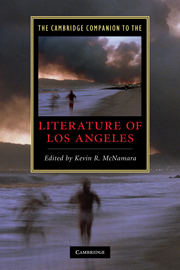Book contents
- Frontmatter
- Introduction: landmarks
- 1 The literature of the Californios
- 2 The Anglo invention of Los Angeles
- 3 LA fiction through mid-century
- 4 British expatriates and German exiles in 1930s-1940s Los Angeles
- 5 Postwar Los Angeles: suburban Eden and the fall into history
- 6 Los Angeles and the African-American literary imagination
- 7 Pacific Rim city: Asian-American and Latino literature
- 8 The literature of urban rebellion
- 9 City of sleuths
- 10 Los Angeles’ science fiction futures
- 11 Hollywood fictions
- 12 The Southland on screen
- 13 Scenes and movements in Southern California poetry
- 14 Surf, sagebrush, and cement rivers: Reimagining nature in Los Angeles
- 15 Essaying Los Angeles
- Guide to further reading
- Index
7 - Pacific Rim city: Asian-American and Latino literature
Published online by Cambridge University Press: 28 May 2010
- Frontmatter
- Introduction: landmarks
- 1 The literature of the Californios
- 2 The Anglo invention of Los Angeles
- 3 LA fiction through mid-century
- 4 British expatriates and German exiles in 1930s-1940s Los Angeles
- 5 Postwar Los Angeles: suburban Eden and the fall into history
- 6 Los Angeles and the African-American literary imagination
- 7 Pacific Rim city: Asian-American and Latino literature
- 8 The literature of urban rebellion
- 9 City of sleuths
- 10 Los Angeles’ science fiction futures
- 11 Hollywood fictions
- 12 The Southland on screen
- 13 Scenes and movements in Southern California poetry
- 14 Surf, sagebrush, and cement rivers: Reimagining nature in Los Angeles
- 15 Essaying Los Angeles
- Guide to further reading
- Index
Summary
The Pacific Fish Center is an unlikely destination for Korean tourists, but in the summertime thousands bring their visiting relatives and friends from Korea to this ramshackle eatery on a well-trodden portion of Redondo Beach Pier, about a dozen miles south of Los Angeles International Airport. All sorts of bivalve mollusks, shrimp, and - most importantly for these customers - crab and lobster swim in individual tanks in the front of the restaurant, a marine manifestation of Southern California's seeming treasure. Here, one can enjoy seafood with plates of kimchi, the staple Korean side dish of spicy pickled cabbage, as well as soju, the fermented, potato-derived beverage that in Los Angeles is as commonly consumed as Japanese sake. Here, the tourists' server is unlikely to be Korean himself; rather, he will probably hail from El Salvador or Guatemala, but will still converse fluently in Korean with staff and clientele alike. While visitors to Los Angeles may initially marvel at such proficiency in someone who looks nothing like themselves, the longtime residents of Southern California's many Koreatowns will barely skip a beat, and instead complain that their steamed king crab hasn't arrived soon enough. The server will apologize and bark at a fellow Latino feverishly keeping up with similar orders to hurry up - in Korean. Twenty miles eastward and inland, in an unassuming storefront sandwiched between a clothing store and another restaurant, young Koreans work late into the night creating a flyer in three languages: Korean, English, Spanish.
- Type
- Chapter
- Information
- The Cambridge Companion to the Literature of Los Angeles , pp. 87 - 100Publisher: Cambridge University PressPrint publication year: 2010
- 1
- Cited by



